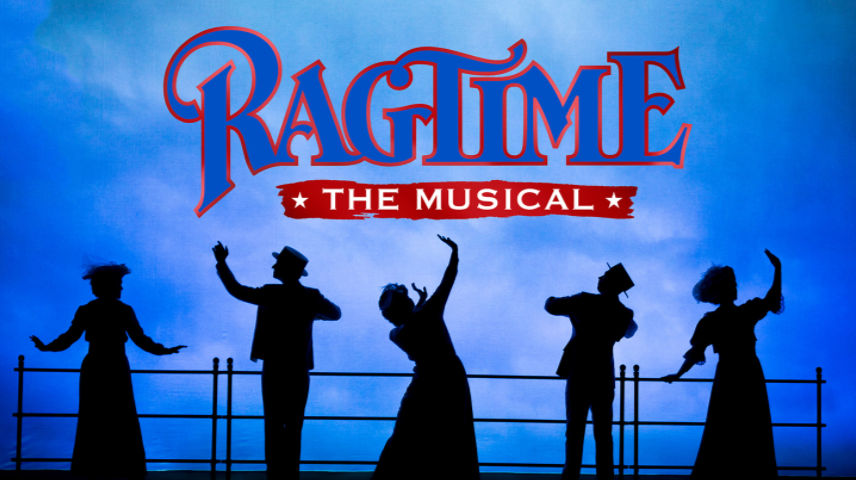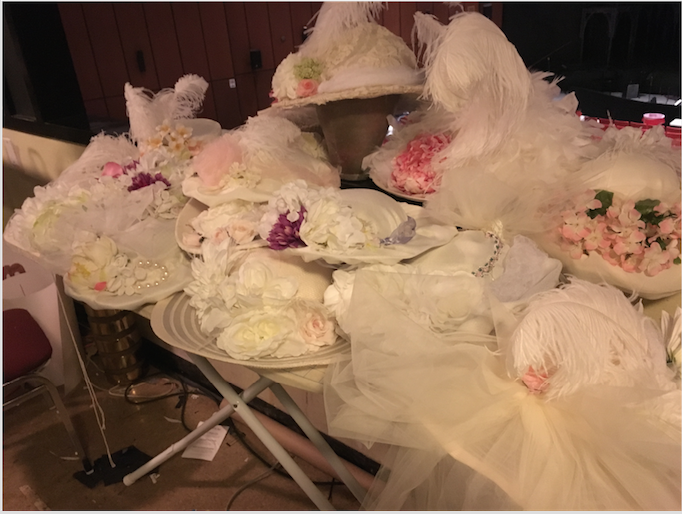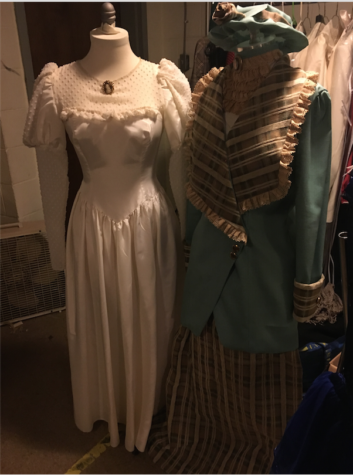Eastside takes you behind the scenes of Ragtime
March 9, 2017
The cast of this year’s Spring Musical will not only take the stage to entertain its audience, but to get them talking. The Theatre Department will be putting on Ragtime, a show based on the 1975 novel by E.L Doctorow. This year will be the first-time Ragtime has been performed on the East stage.
“I love the show and I love the message of the show, there is no doubt about that, I think the music is absolutely beautiful,” said Director, Mr. Tom Weaver.
This show was chosen primarily for its storyline and message centered on racism and stereotypes in early twentieth century America. Ragtime has a complex plot, following three families whose storyline interconnect during turn-of-the-century New York.
“It’s the power in the storyline, it’s not a fluffy storyline,” said Weaver. “A lot of musicals have somewhat traditional, predictable themes, predictable storylines. You know the outcome halfway through the story. This show, there’s some surprises at the end and empowerment.”
In addition to a deep yet entertaining storyline, Ragtime will feature singing, dancing and even a little bit of magic.
Like past productions, the Theatre Department will be using the company Flying by Foy, a theatrical flying service, in order to enhance several scenes throughout the show. This year the flying will be in the form of a swing, in which the character Evelyn Nesbit will be introduced. As well, magic will take form in the famous magician, Harry Houdini.
The set itself will have an industrial feel to it, similar to the set the scenic designer, Eugene Lee, used for the Broadway production of Ragtime.
“The set will have metal, scaffolding, open steel, high beams, lots of rivets type of feel and that’s the style that we are going to try to get with the help of the projections,” said Weaver.
There will also be special effects in the form of LED lights, which will be used to set the scene and show projections.
“Mr. Weaver has asked for rear projections, and actually this year we have looked into hiring a company that does an LED wall, similar to what you would see at the Comcast building…panels that are put together to make one big screen so we are excited to use that,” said Technical Director, Mr. Peter Gambino.
These projections will be used to set the scene and give the audience some context as pictures from 1906 will be shown. Combined with music, dance, lights and costumes, the audience will have a full experience, said Gambino.
While the play will be worth seeing from an entertainment standpoint, it will also be moving in how it brings to light some of the issues that exist now.
“If you like jazz music and up-tempo dancing I think you will be very pleased with the show, in terms of the spectacle level,” said Gambino. “In terms of content, I think what makes Ragtime special is that is brings up some pertinent issues that I think we are talking about now in the newspapers…Things about race and tolerance and acceptance and trying to make your way…I think this play tackles a lot of those things and it’s important to showcase and kind of get an area for a challenging concept to be presented.”
It is the social commentary that will set Ragtime apart from the musicals East has done in the past. Weaver said that audience members should leave emotionally touched and thinking about their beliefs in context to social issues today.
“This show is emotionally charged and it will make us better human beings I think if we do our job well…You want to spice things up and get people talking about life and how we communicate with each other and how we take care of each other, how we might worry about life with each other and we need to understand each other’s differences, and once we do that through musicals like this, we all become better human beings for it,” said Weaver. “I’m the most proud of that, and I think we are going to make Cherry Hill Public Schools very proud.”
Ragtime will be opening on March 10 with additional shows on the 11, 12, 17, 18 and 19.
The Audition: Brr! Brr! Mah!
Cooper details her experience auditioning for the show.
Before the stage manager can even finish reciting my name, I am already up and out of my seat moving toward the stage. Butterflies gently dance around in my stomach. A pounding drum pulsates to a steady beat in my skull. My feet quiver as I slowly move up the stage stairs. Months of dedication and practice culminate into one five-minute experience. The Audition. My irrefutable excitement is nearly encapsulated by my uncontrollable nervous anxiety.
And then I am there and my feet touch down on the edge of the pitch-black stage. As the lights shine down upon my face, I practice square breathing to center myself.
Breathe in
1…2…3…4
Hold
1…2…3…4
Breathe out
1…2…3…4
Now is the time to bear my most vulnerable self. To let go of all reservations and insecurities. To truly be free.
My feet have finally reached the green “X” taped down on center stage. The lights blare into my eyes now with more intensity. I can no longer see the audience in front of me, yet I must still exude confidence. A beaming smile spreads its way across my lips as I begin to slate my name.
Hi, my name is Ashley Cooper and I will be auditioning for the part of…
The accompaniment begins to play. Physically, I can sense melodic lines steadily spilling out of my mouth. But consciously I am unaware of what is happening. I let the music guide to where I need to go. My body moves without thought or prompting. It as if my spirit commands me, rather than my mind.
In this moment, I am triumphant.
I am unstoppable.
I am my character.

Meet the Cast
Behind the Scenes at East

Stage Crew brings the show to life
The cast and crew of this year’s spring musical have both put a lot of work into preparing Ragtime for the East stage. A team of about 50 people have worked along crew heads to make the production come to life. With an industrial style setting, the set for Ragtime differs greatly from that of other musicals in the past.
One of the main unique aspects of this year’s set is the large LED screen which will be integrated into the production as a backdrop that projects images.
“We are pretty excited, it’s a cool window into the past and there’s something really special about looking at old pictures so we hope that that helps set the scene and gives the audience some sort of context,” said Mr. Peter Gambino, Technical Director. “It will be essentially the backdrop, so as normally you would come and see a colored backdrop, what we call the cyc, it will be a screen, and Mr. Weaver has designed a set that is very reminiscent of the Eugene Lee set with a lot of platforms and steel girders and then there will be a projection screen in the back.”
Listen to our Interview with Mr. Weaver about stage crew and the technical effects!
The lighting crew will also be integrating new LED lights which offer many different colors that can be used to add effects to a scene.
“The LEDs, we bought them for The Miracle Worker, and we have been learning how to use them properly from an alumnus who has been teaching us over the last few months,” said Lighting Crew Head, Naomi Burton (’17). “They are more state-of- the-art, not like standard, conventional lighting, easier to use and more professional.”
Because the LED screen will help set the scenes for the audience, the set design is much more simple in how it will portray setting.
“This show is minimal and abstract in a way…. There are very large pieces that represent different areas and I was able to use a lot of different techniques and a lot of texture to make sure that these simple pieces [of the set] have some sort of depth to them,” said Sam Brenner (’17), the scenic artist for the show. “We are putting in a 40-foot-wide by 21 feet high LED screen. Mr. Gambino has spent the last month or so editing these photos to be used as a backdrop instead of buying backdrops for the show, its these beautiful pictures to give the setting…You go to a certain location [in the play] without a lot of set.”
As well, the stage will portray the time of industrialization that was taking place during Ragtime through the detail and research that has been put into constructing the set.
“It’s the turn of the century so metal work has become really popular… everything keeps relating back to that time period because that’s really important to understand,” said Brenner. “It’s a lot of detail on how things were built back then or how were the windows designed, it changes throughout time, so to put someone in that setting you have to do a lot of research… there’s a lot of detail involved.”
As the LED screen makes it way on the set, and final touches are made, the stage will be ready to show off the hard work of many on opening night.
Danny’s Experience as Stage Manager
In order for a show to work, two things are needed: a cast and a crew. But, in order to make these two groups work as efficiently as possible, it is necessary to have a stage manager. It is not an easy job, and it can be extremely stressful depending on the show, but it is one that I enjoy doing just as well.
I started as Stage Manager for the Drama Department in September for the Lab Theatre production, Get Bill Shakespeare Off the Stage. Since then, I have become Assistant Stage Manager working alongside my two fellow Stage Managers, Allison Donahue (‘18) and Taryn Rummell (‘19), in addition to my role as Prop Master that I started last year. Being Stage Manager has certainly been an interesting experience, especially during Ragtime. As there is so much more going on in this show than in the fall play and Lab Theatre, we have been doing much more as well. Rehearsals happen almost every day after school, and when compounded with Stage Crew, it is unlikely that I am able to get home until about ten at night.
As Stage Managers, we are responsible for helping to create the rehearsal schedules so that they work with the conflicts of the cast, making sure we have the blocking for every scene in the event that an actor forgets it during a run-through and assisting Director Mr. Tom Weaver, Technical Director Mr. Peter Gambino, and choreographer Mrs. Sandy Makofsky during rehearsals with whatever they need to make the rehearsal run as smoothly as possible. It is easier said than done, as there are problems that can arise in an instant that can complicate our jobs and halt the production of the show, if only momentarily.
This is not even mentioning what we do during the actual show itself. We are responsible for calling stage cues and making sure scene changes happen as fast and efficiently as possible. If any of us slack off for even a moment, it could possibly ruin the scene at best, and get someone hurt at worst. This is going to be true for this show especially, as we are going to fly actors at multiple points in the show and we are working in very tight conditions backstage, making maneuvering the bigger set pieces in the show a challenge.
An additional challenge for me is that fact that I am also the Prop Master for the Drama Department, meaning that I am in charge of obtaining and maintaining all of the hand props and furniture that is used in the show. While this does not sound too difficult, it is a job that has proven itself to be easier said than done, particularly during shows like Ragtime that take place in a specific time period.
The reason for this is that every prop used in the show need to appear to be from the early-1900s, which is relatively easy for something like a vase but is surprisingly much harder for something like a camera or even a baseball mitt. The difficulty of obtaining each prop varies, but can mostly be attributed to either it’s difficult to recreate with the supplies we have or how expensive it would be to buy. The later tends to be the case more often with shows that are dated as early as this one.
Overall, though, I really do enjoy working on the show in either of the roles that I fill. Being a Stage Manager is extremely rewarding, as pulling off a difficult scene change is very gratifying. I also love being Prop Master, as I can to work with and create some of the most interesting and awesome things every show. The difficulties involved are greatly outweighed by what I get in return for my effort. It is truly an honor to be able to be so involved with production as amazing as this one.
Orchestra: Pulling all the Strings
During the production of any musical, the audience focuses on the stage, the set and the actors. The audience hears the music and the sound, but they wonder: from where are these beautiful sounds flowing?At a lower level in front of the onstage production sits a collection of 30 or so students who make up Cherry Hill East’s pit orchestra. Conducted by Mr. Tim Keleher, the pit orchestra plays the music and creates some of the sound effects for all of the theatre productions at East. Composed of students from both the symphony orchestra and the jazz band, the pit orchestra’s members are subject to change for each new show.
Listen to our interview with Mr. Weaver about Orchestra!
This year’s spring musical, Ragtime, features a very specific style of jazz. In fact, this style “ragtime” is historically the first form of jazz music. Thus, students who played in the pit last year for Beauty and the Beast with a more classical style of music may differ from this year’s compilation of students, which leans more toward jazz band than symphony orchestra. “Each Broadway show is different for what they write for, as far as what instruments… Ragtime has more jazz band with saxophone and brass and a rhythm section on top of the strings,” said Keleher.
Also different from Beauty and the Beast, the pit orchestra continuously plays throughout Ragtime as the production is nonstop. A traditional musical play like Beauty and the Beast provides the orchestra an opportunity to rest and switch sheet music in between songs or scenes, unlike the vigorous pace of Ragtime.
Keleher said, “It’s a very intense concentration, you can’t let up and kind of think about something else while the play is going on. You’re concentrating for the whole two and a half [to] three hours of the show, and that’s a new skill for our young musicians to develop… its requires a great deal of focus.”
In order to prepare for such a task, Keleher said the pit starts with reading rehearsals in December in which they play through the music casually to simply get an idea of the music. In January, the pit begins its more intense rehearsals for the musical starting at twice a week for two hours and adding more rehearsals as the production approaches.
“We do practice separately, just the musicians first learning the music, and then we begin integrating the singers,” said Keleher. “Especially for Ragtime we started doing this because the music is very difficult and very complicated, not just for the orchestra but also for the actors.”
Despite the severe change in musical style, the advanced pit does not encounter trouble, but rather challenges which grow into learning experiences. The students indulge in their current works and learn to adapt to the new style like professional musicians.
“[The pit orchestra] may be a little bit ‘overworked’ but not under appreciated,” said Keleher.
A lot of hard work goes in on pit orchestra’s part as it contributes to more than just the music in the show and need to work accordingly with two casts of actors, the crew, the conductor and one another. Hidden below the production onstage is more than just violins and cellos using the best cello strings; there lies a compilation of immense talent and grand effort.
Costume Change!
Exiting through the side door of the Little Theatre, I am led across the main hallway of D-Wing and into the side door of the Auditorium. Gabi Stahl (‘17), Wardrobe Manager, leads me through one final door in the back of the Auditorium and up a flight of stairs. Our location: the balcony of the Auditorium.
Hats seem to border the perimeter of the room, being mounted on walls and overflowing on tables. Two mannequins wear costumes for Ragtime. In the center of the room is a large table covered in bits of fabric, papers, measuring tapes, pin cushions and other various objects. The back of the room holds two long costume racks, stuffed with costumes and marked with a sign that says “Everything must be labeled.” There is a large hole in place of a front wall, so there is a view of the entire auditorium and stage.
This year, the Costume Department for the Cherry Hill High School East Theatre Department has been working since the end of the fall play, The Miracle Worker, to create all the costumes for the spring musical, Ragtime. The Costume Department is mainly comprised of two seniors, two juniors, five sophomores, a couple freshmen and two adults from outside of East.
“It’s not a huge team for the amount of stuff we have to turn out. There’s over 100 people in the cast, but we work hard,” said Stahl.
They work after school every Tuesday and Thursday, as well as on Saturdays to complete the costumes for Ragtime. This year, the costumes fit into three main categories: New Rochelle, immigrants and Harlem.
“There’s kinda three classes of people. There’s the people of New Rochelle, which are like upper-class, white people,” said Stahl.
The costumes for the people of New Rochelle are white in color and embellished with frills.
“And then there’s the immigrants, who are from mostly Europe. They’re kinda in darker clothes, little rags kind of, coats, and they’re very muted colors,” said Stahl.
The third class is the Harlems, which are the African Americans.
“They wear a lot of fun colors. They also wear hats, but not as decorated…they wear a lot of skirts and belts so that they can dance around more,” said Stahl.
Costumes come from past plays are recycled. Pieces for costumes also come from thrift stores. Most of the costumes are made in house. The costumes are mostly completed by “Hell Week,” or the week prior to opening night. However, the Costume Department works tirelessly to make finishing touches and finals tweaks up until opening night and then through the duration of the play.
“You have to tweak things, or people lose things. Then you have to plan out makeup, and there’s all these problems,” said Stahl.
There is a separate hair and makeup department, but most students work on both the costume department and hair and makeup department. The costumes for Ragtime can be expected to be as amazing as the play itself.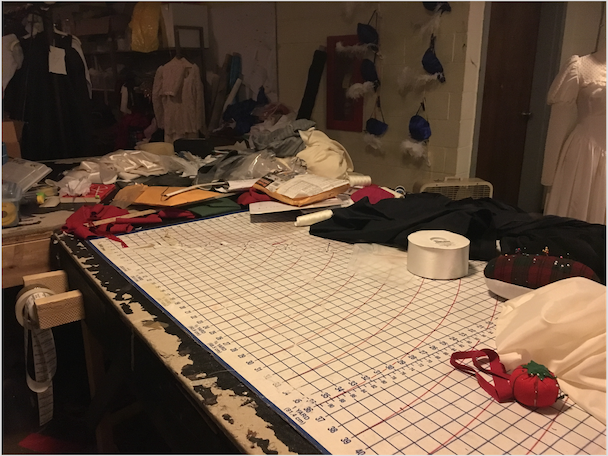
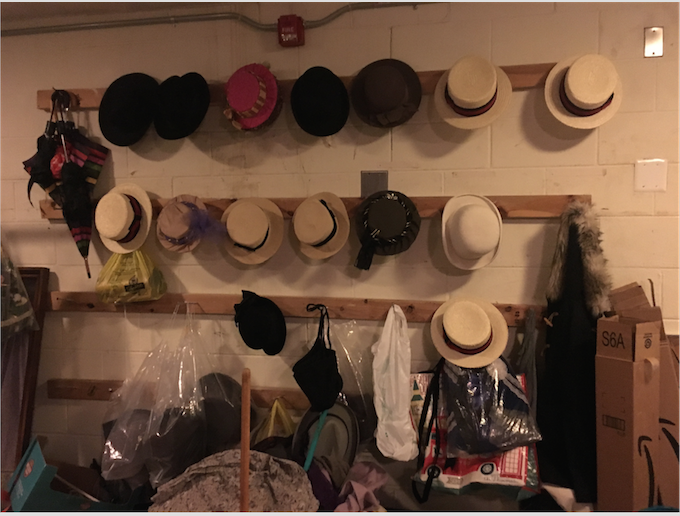
Choreography: The Show must go on!
She learned her first Vaudeville routine at 18 months old from her grandfather, a Vaudeville performer himself who taught her how to ‘Shuffle off to Buffalo’. As she danced her way through childhood, from her first experience as a choreographer in a middle school dance show to her work in high school as an assistant choreographer for her school plays, her passion grew into a lifetime focus. Now, decades later, Mrs. Sandi Makofsky continues to draw inspiration from her long and varied career in choreography as she applies vaudeville, ragtime, proper step dancing, staging, and many other styles of motion to this spring’s production of Ragtime at Cherry Hill High School East.
“The thing I love about Ragtime, besides that it’s such an important piece, an important to be seen, is that none of the choreography is gratuitous,” said Makofsky. “You have these fun, light fluff shows, like Anything Goes, where somebody says something, they drop a dime, and then they start dancing. [In Ragtime], all of the choreography comes directly from the dialogue, or from the theme, or from whatever’s happening at that moment in time.”
She estimated that there are about thirty-three total numbers in Ragtime that involve some kind of dance. This includes several particularly elaborate, showstopping dance numbers, including an elaborate piece set in Atlantic City and an opening number clocking in at over seven minutes long. However, also included in the lineup are many pieces with a more subtle style of choreography called staging. Staging is utilized in any scene with a song, including duets and trios, and basically just indicates blocking in time to the music that is less stylized than a full ensemble dance and relates to the lyrics being performed. Generally, Makofsky describes her Ragtime choreography as “a mix of things…Very broadway… very typical classical Broadway.”
Listen to our interview with Mr. Weaver on choreography!
Some of the notable “staged” numbers in Ragtime include a Vaudevillian piece featuring the character Evelyn Nesbit, which Makofsky fondly describes as “fun” and “ridiculous,” and an all-male number set at a baseball game – which is a particular cast favorite. While Makofsky herself enjoys the unique challenges that planning and executing each type of dance piece presents, her favorite are the large ensemble numbers.
“Although they’re the most difficult, they give you the most payback,” she explained. “When everybody gets it, it’s very exciting for them, and it’s very exciting for me.”
In addition to the varying sizes and circumstances of each number, there are several specific styles of dance that are utilized primarily in the play; the most prevalent, of course, being ragtime dance. “Proper” dances, like the two-step, as well as a little bit of Vaudeville are also utilized, according to Makofsky.
Considering how easy experienced thespians can make complex choreography look on stage, it’s easy to forget how much intense preparation and planning is required to pull off any good show. Makofsky takes into consideration a myriad of factors when designing the choreography of each number. Her primary concerns involve the performers – their skill level, their stage placement, and how many there are.
“I plan very, very carefully. It’s like a big math problem… it’s always a work in progress,” she said. “I never am done until the last performance.”
Luckily, Makofsky doesn’t have to do it alone; she works with student dance captains who act as leaders among their peers during the rehearsal process, assisting her with running numbers, evaluating areas for improvement, and so on. Makofsky specified that her student dance captains are typically upperclassmen who she feels have proven themselves within the department in terms of responsibility and skill level, and who are respected by younger thespians. So, how exactly does Makofsky go about translating her choreography ideas into physical motion?
“I listen to the music, I read the script, I read the script again, I listen to the music some more; and then I kind of just see pictures in my head…” she said. “What’s in my brain sort of translates into certain steps.”
Her next challenge is navigating the complex rehearsal schedule in order to ensure that every last cast member is able to have sufficient time to learn and practice their choreography. Because there are so many different departments that cast members must interact with in ever to pull off a complete show, from vocal to costumes, Makofsky’s timeframe varies every week. On average, she comes to East about three times a week, for two and a half to three hours at a time. Within this timeframe, she staggers the rehearsals of each individual aspect of a piece based on who is needed. A principal actor might come in at the beginning of a rehearsal to work on a solo, then a smaller group which that principal is also involved in might arrive 45 minutes later to work on a larger piece. On Saturdays, these elaborate jigsaw puzzles of preparation come together as full numbers are run, reviewed, and improved. According to Makofsky, “It’s like a well-oiled machine at this point.”
Makofsky is no stranger to the East Drama Department; she has been working with director Mr. Tom Weaver for years, since their first joint effort on a production in Washington Township. Over the years, the dynamic duo have become close friends as well as creative collaborators.
“We have a symbiotic relationship. He’s a very, very magnanimous director,” said Makofsky.
In addition to her work at East, Makofsky is also the drama director at Carusi Middle School and the resident director at Voorhees Theater Company. She has worked all throughout New York, New Jersey, and Pennsylvania with various middle schools, high schools and colleges, as well as contributing to commercial projects and various industrial films. It’s been a jam-packed career, but Makofsky wouldn’t have it any other way. “I always say it beats a ‘nine-to-five’,” she declared. “I’d be bored.”
As preparations for the spring production of Ragtime continue, Makofsky urges students to consider involvement in the vast realm of theater. “The skills that you learn in theater, regardless of what you do in your lifetime, will help you,” she said. “If you have any interest in it whatsoever, don’t be afraid to do it. It is a very inviting place and the payback is amazing. I don’t mean just the applause, I mean what you get out of it. You get a family.”
The Closing Credits: Thank you for Watching!
Thank you for reading Eastside’s report on Ragtime. We hope you enjoyed our stories and special features. The show starts today, March 9th! Members of the East Theatre Department will be performing for 9th and 10th graders during the school day. Thank you for reading (and watching!) before you enjoy the musical.
